Every year, thousands of students and job seekers study hard for data analytics roles —
yet still fail at interviews.
Why?
Because they unknowingly fall into common traps:
- Random, unfocused learning ("learning everything" instead of the right things).
- Memorizing without understanding, so they crumble when faced with case questions.
- Weak application skills — knowing formulas but not how to use them in real-world scenarios.
- Unstructured answers that confuse interviewers instead of impressing them.
- Poor mock preparation, leading to panic and blanking out during real interviews.
- Crippling stress and self-doubt even after knowing the material.
It’s not a knowledge problem. It’s a preparation system problem.
Introducing the SPARK Framework — Powered by U2xAI: A Smarter, Proven Success Path
To solve these exact problems, we designed the SPARK Framework —
a proven, AI-powered method trusted by thousands of students who successfully transitioned into top analytics roles.
SPARK stands for:
- Structured Learning
- Practical Case Mastery
- Actionable Answer Practice
- Real Interview Simulations
- Killer Mindset Training
And here’s the best part:
Using U2xAI alongside SPARK, every student gets a personalized learning and practicing experience — at their own pace, without stress, and with full guidance at every step.
No guesswork.
No confusion.
No last-minute cramming.
Just clear daily action plans, hands-on exercises, real-world mock interviews, and mindset training — designed to make you feel confident, capable, and calm by the time you reach your interview.
Proven Results:
Thousands of students have already followed the SPARK path and:
- Built real job-ready skills in just a few weeks.
- Cracked their first or second interview attempts.
- Felt calm, confident, and in control during technical rounds and case discussions.
- Launched careers at companies across supply chain, finance, consulting, and tech.
Your Journey Starts Here:
In the next 21 days, following the SPARK Framework powered by U2xAI,
you will:
- Master technical foundations (Python, SQL, Statistics, Visualization),
- Solve business problems practically (Supply Chain, Sales, Operations cases),
- Communicate structured, impressive answers (SPAR Method),
- Simulate real interviews weekly, and
- Strengthen your mindset to perform like a pro — even under pressure.
The SPARK System isn’t just about passing interviews — it’s about becoming someone ready to succeed.
Welcome to the Success Path. Your transformation begins now.
Purpose of Week 1: Core Foundations
This week builds your strong roots in Python, SQL, and Supply Chain Fundamentals — not by memorizing, but by deeply understanding, practicing real-world cases, building structured answers, simulating interviews, and strengthening your mindset.
Every day, you'll apply the SPARK Framework, and U2xAI will act as your personal trainer for every single SPARK activity:
What You Will Learn in Week 1:
| Area | Key Learning Highlights |
|---|---|
| Python Foundations | - Understand variables, data types (int, float, string, bool) in real-world datasets. - Learn data structures (lists, dictionaries, sets, tuples) and how businesses organize data. - Write basic functions and loops to automate simple data tasks like discount calculations. |
| SQL Fundamentals | - Master basic SQL queries: SELECT, WHERE, ORDER BY to extract clean data. - Learn JOINs, GROUP BY, and aggregation functions like SUM() to combine and summarize multiple datasets. - Apply SQL on realistic scenarios like analyzing sales orders and inventory. |
| Supply Chain Basics | - Understand the basic flow: Supplier → Manufacturer → Distributor → Customer. - Connect analytics skills to real business processes like procurement, production, and distribution. - Analyze how data supports operations and decision-making in the supply chain. |
| Interview Skills | - Practice structured answering (SPAR method) daily. - Start early mock interviews (technical + business focus). - Receive daily mindset and visualization training to build confidence. |
By the End of Week 1, You Will Be Able To:
- Clearly explain core Python and SQL concepts (What, Why, How) with real-world relevance.
- Apply Python and SQL skills to realistic business scenarios (like sales reporting and inventory analysis).
- Understand basic supply chain processes and connect them to data analytics roles.
- Practice structured answers for common technical and business questions.
- Simulate mini-interviews and get feedback to fix gaps early.
- Train your mindset daily to stay calm and confident during real interviews.
Week-1 Day By Day Task List:
Day 1: Introduction to Python for Analytics
Introduction:
Today, you'll build a real conceptual understanding of Python — starting from what a variable really is to how it’s used in real analytics.
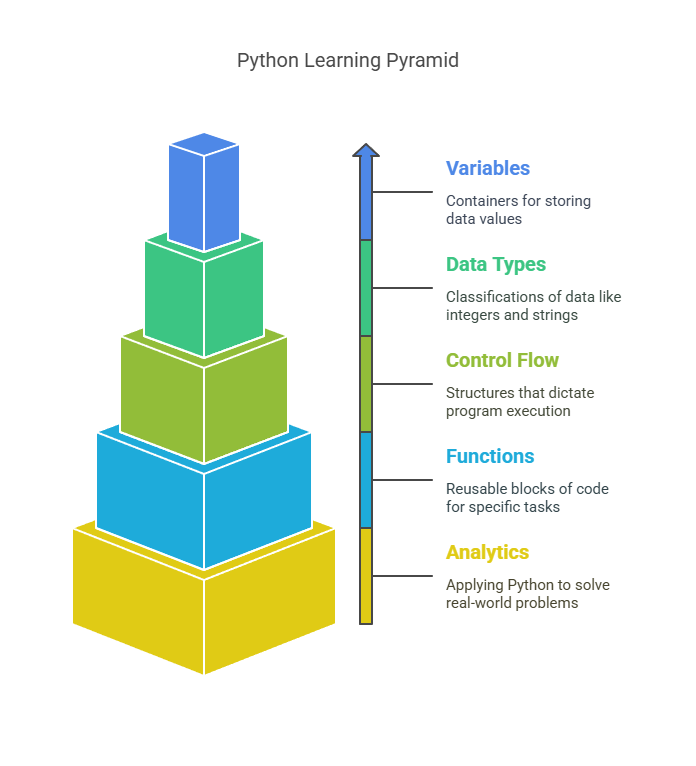
How to Use U2xAI for SPARK:
- Structured Learning (S):
➔ Ask U2xAI to explain variables and data types simply — What, Why, How (e.g., "Explain int, float, string with examples from retail datasets"). - Practical Case Mastery (P):
➔ Request U2xAI to give examples like "How would an inventory system use variables?" - Actionable Practice (A):
➔ Solve 3 mini-assignments like creating a stock quantity variable or a sales_price variable with U2xAI checking your answers. - Real Interview Simulations (R):
➔ Simulate 5 short technical questions with U2xAI:
"What is a boolean? Give a real-world example." - Killer Mindset Training (K):
➔ U2xAI guides you through a 2-minute confidence exercise before starting the coding exercises.
Day 2: Python – Data Structures
Introduction:
Today you’ll understand the building blocks of data organization — how companies structure millions of pieces of information efficiently.
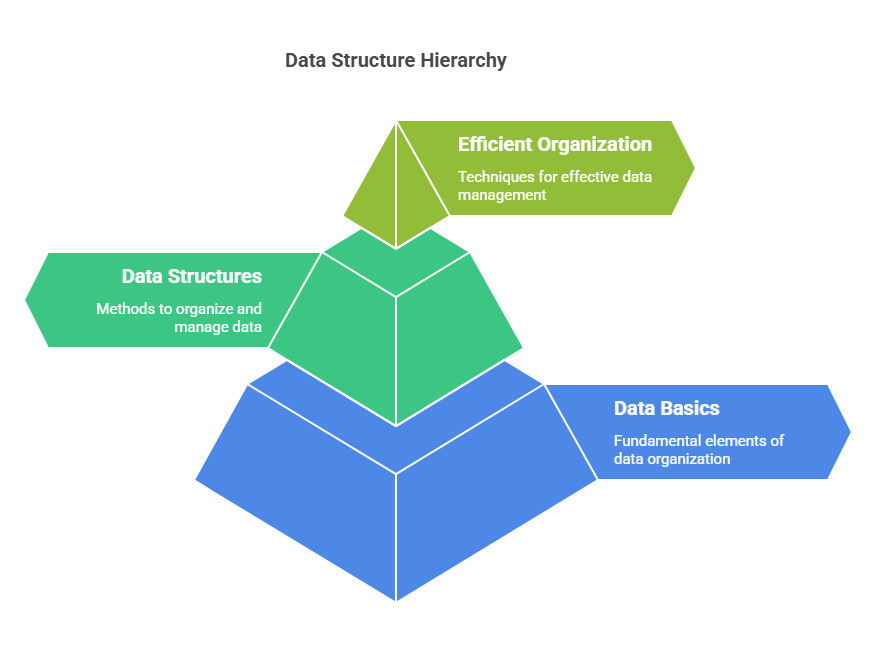
How to Use U2xAI for SPARK:
- Structured Learning (S):
➔ Get simple explanations and comparisons: When to use a list, when to use a dictionary. - Practical Case Mastery (P):
➔ Request cases: "Model an inventory catalog using Python dictionaries." - Actionable Practice (A):
➔ Practice 5 mini-exercises (like adding products to a list, updating stock quantities). - Real Interview Simulations (R):
➔ Mock interview questions like "Which data structure would you use to store customer orders?" - Killer Mindset Training (K):
➔ U2xAI provides a mindset tip for problem-solving patience when debugging.
Day 3: Python – Functions and Loops
Introduction:
Functions and loops are the core of automation in analytics — today you’ll practice writing small but powerful programs.
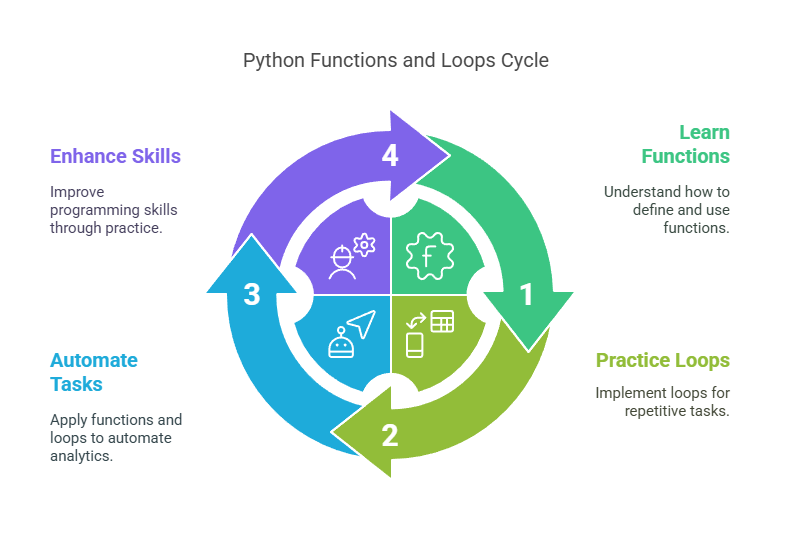
How to Use U2xAI for SPARK:
- Structured Learning (S):
➔ Ask U2xAI to explain: Why use functions in business data analysis? - Practical Case Mastery (P):
➔ Request mini projects: "Build a discount calculator for an online store." - Actionable Practice (A):
➔ Solve 2-3 function-based tasks; U2xAI gives code reviews. - Real Interview Simulations (R):
➔ Practice live function-writing questions in mock mode: "Write a function that calculates monthly sales revenue." - Killer Mindset Training (K):
➔ Deep breathing + visualization: Visualize calmly handling a live coding test.
Day 4: SQL – Basic Queries
Introduction:
Today you’ll unlock the power of SQL to retrieve clean, useful data for analysis — a must-have real-world skill.
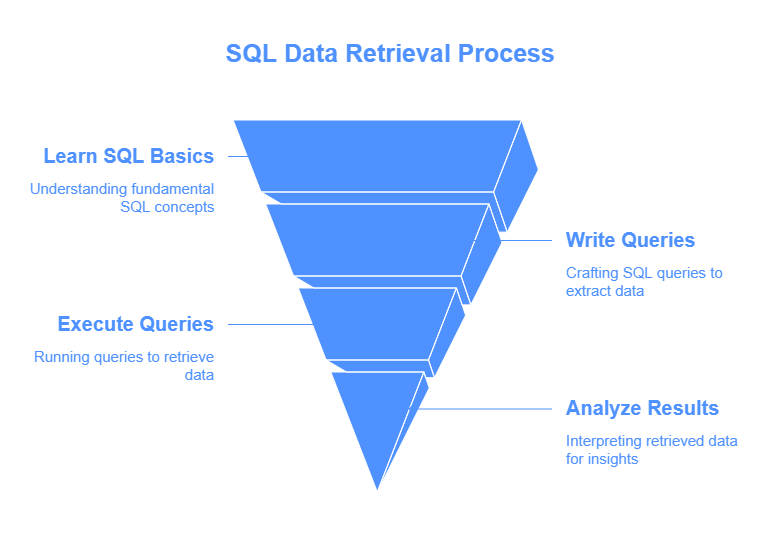
How to Use U2xAI for SPARK:
- Structured Learning (S):
➔ Learn SELECT, WHERE, ORDER BY explained with real examples (like customer order history). - Practical Case Mastery (P):
➔ Generate small retail datasets; practice querying only customers with orders > $100. - Actionable Practice (A):
➔ Solve 5 query-writing exercises with immediate feedback. - Real Interview Simulations (R):
➔ Mock interview session: "Retrieve the top 5 selling products." - Killer Mindset Training (K):
➔ Affirmations: "I can calmly think through SQL logic step-by-step."
Day 5: SQL – JOINs and Aggregations
Introduction:
Today you’ll combine multiple datasets — a key analytics skill for building dashboards and generating insights.
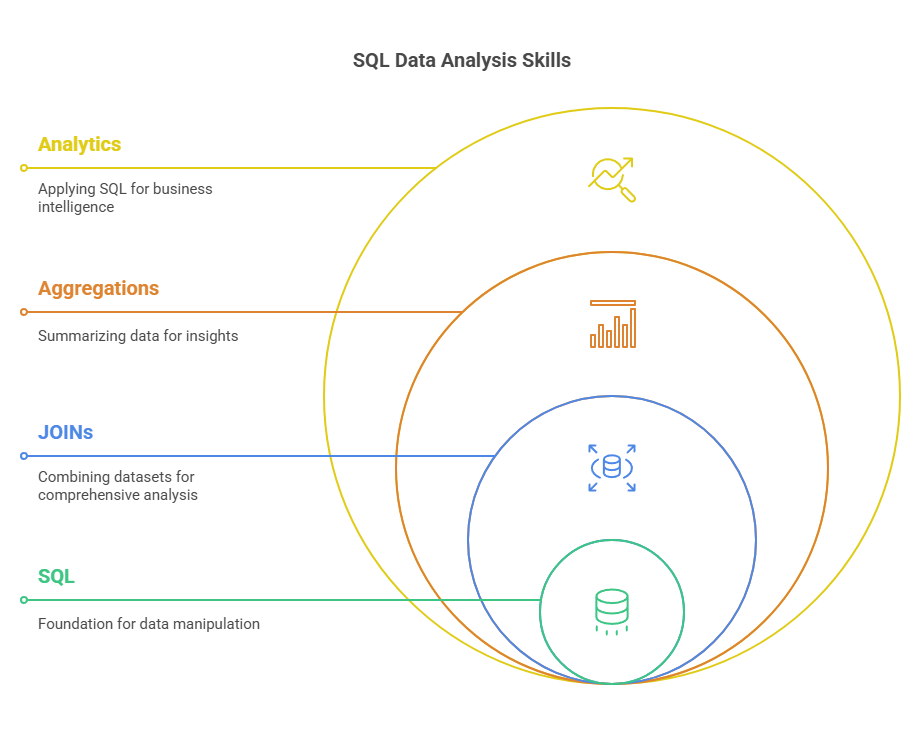
How to Use U2xAI for SPARK:
- Structured Learning (S):
➔ U2xAI explains INNER JOIN, GROUP BY, and SUM() with business scenarios. - Practical Case Mastery (P):
➔ Generate practice: Merge a sales table with a product table. - Actionable Practice (A):
➔ Do 5 JOIN + aggregation exercises with performance feedback. - Real Interview Simulations (R):
➔ Practice question: "Find total revenue by category." - Killer Mindset Training (K):
➔ U2xAI teaches mental visualization: "Picture your two tables merging smoothly."
Day 6: Supply Chain Fundamentals
Introduction:
Today you connect analytics skills to understanding business operations — the real systems behind the data.
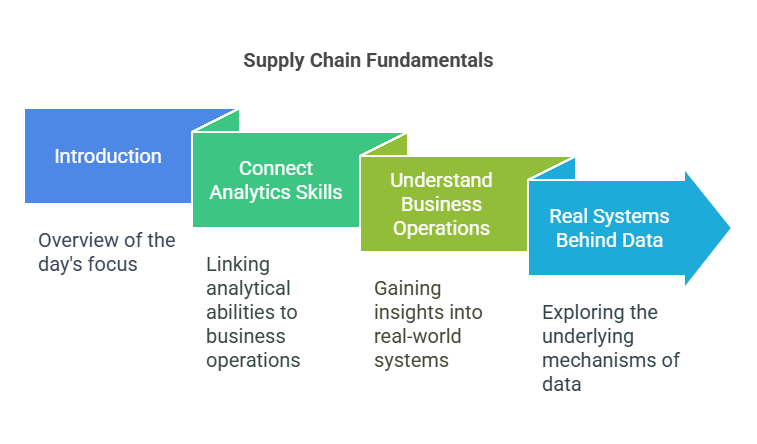
How to Use U2xAI for SPARK:
- Structured Learning (S):
➔ Ask for supply chain flow explanations with examples (Supplier ➔ Manufacturer ➔ Customer). - Practical Case Mastery (P):
➔ Solve 5 mini-scenarios (like shipment delays impacting stock levels). - Actionable Practice (A):
➔ Practice quick-response business questions with data connections. - Real Interview Simulations (R):
➔ Case practice: "What KPIs would you track for a delayed shipment issue?" - Killer Mindset Training (K):
➔ U2xAI provides confidence visualization for real-world discussion questions.
Day 7: Weekly Mock Interview
Introduction:
Now you bring everything together: coding, SQL, supply chain — under mock interview pressure.
How to Use U2xAI for SPARK:
- Structured Learning (S):
➔ Quickly review key concepts before the mock. - Practical Case Mastery (P):
➔ Apply your knowledge to 2-3 real-world mini-cases. - Actionable Practice (A):
➔ Answer technical + business questions using SPAR structure. - Real Interview Simulations (R):
➔ 30-minute U2xAI mock covering Python, SQL, and business cases. - Killer Mindset Training (K):
➔ U2xAI guides a pre-mock confidence booster + post-mock review.
Purpose of Week 2: Business-Driven Data Mastery
This week shifts your learning from pure tools to practical application:
- How analytics concepts apply in real business situations,
- How data flows through organizations,
- How you think like an analyst solving real-world problems.
U2xAI will coach you every day to follow SPARK — so you're not just "learning," you're preparing like an elite analyst.
"In analytics, data is the raw material, but business understanding is the blueprint."
What You Will Learn in Week 2:
| Area | Key Learning Highlights |
|---|---|
| Statistics for Analysts | - Understand descriptive statistics: Mean, Median, Mode, Range, Variance, Standard Deviation. - Master basic probability: independent events, combinations, and how it relates to forecasting and risk. - Grasp hypothesis testing fundamentals: null/alternative hypotheses, p-values, and real-world A/B testing examples. |
| Data Life Cycle Mastery | - Learn the full data journey: Business Understanding → Data Collection → Cleaning → Analysis → Decision Making. - Focus on Data Cleaning: Fix missing values, outliers, and inconsistencies — build real, hands-on cleaning skills. |
| Business Problem-Solving | - Learn how to translate vague business questions into structured analytics problems. - Practice framing business challenges like customer churn or falling sales into measurable, data-driven action plans. |
| Interview Skills Advancement | - Apply SPAR method more deeply: solve complex business cases with structured answers. - Perform end-to-end analytics problem-solving in mock interviews. - Strengthen business communication and decision-making explanation skills. |
By the End of Week 2, You Will Be Able To:
- Explain and apply descriptive statistics, probability, and hypothesis testing concepts to real data problems.
- Understand and work through the full data life cycle — from raw collection to final decision support.
- Clean messy datasets confidently and discuss your cleaning approach in interviews.
- Frame real-world business problems as clear, actionable analytics projects.
- Perform full mock case interviews simulating real analytics business discussions.
- Think like a problem-solver, not just a tool user — a key differentiator in interviews.
Week-2 Day By Day Task List:
Day 8: Statistics — Descriptive Statistics
Introduction:
Today, you’ll master how to summarize data meaningfully — spotting patterns, central trends, and spread using real datasets.
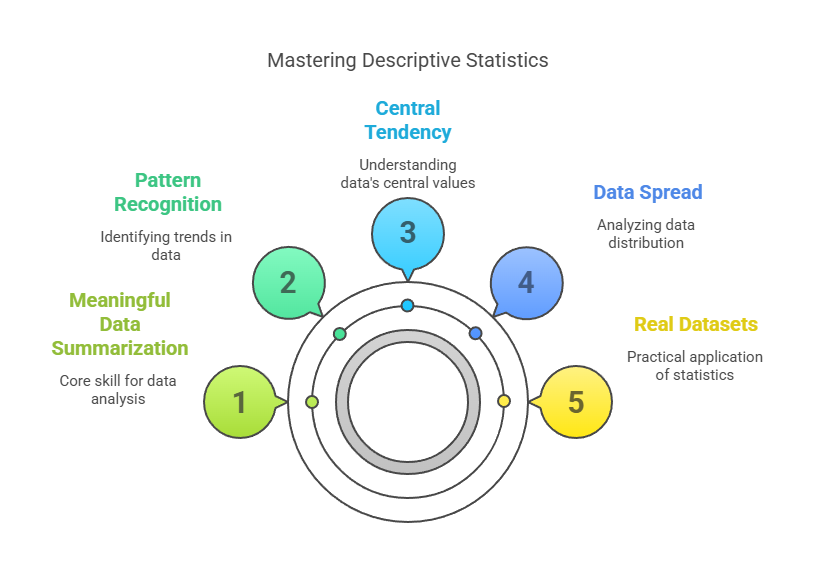
How to Use U2xAI for SPARK:
- Structured Learning (S):
➔ Ask U2xAI to explain Mean, Median, Mode, Variance, and Standard Deviation simply — What, Why, How. - Practical Case Mastery (P):
➔ Request 5 real-world problems using retail sales data (e.g., "Find the average daily sales for January"). - Actionable Practice (A):
➔ Solve 5 quick problems; get instant feedback from U2xAI. - Real Interview Simulations (R):
➔ Simulate mini-interview Q&A: "Explain when median is better than mean." - Killer Mindset Training (K):
➔ Visualize explaining statistical results with calm, simple clarity.
Day 9: Statistics — Probability Basics
Introduction:
Today, you'll build prediction skills: how to calculate and explain the likelihood of events — a vital skill in forecasting and risk management.
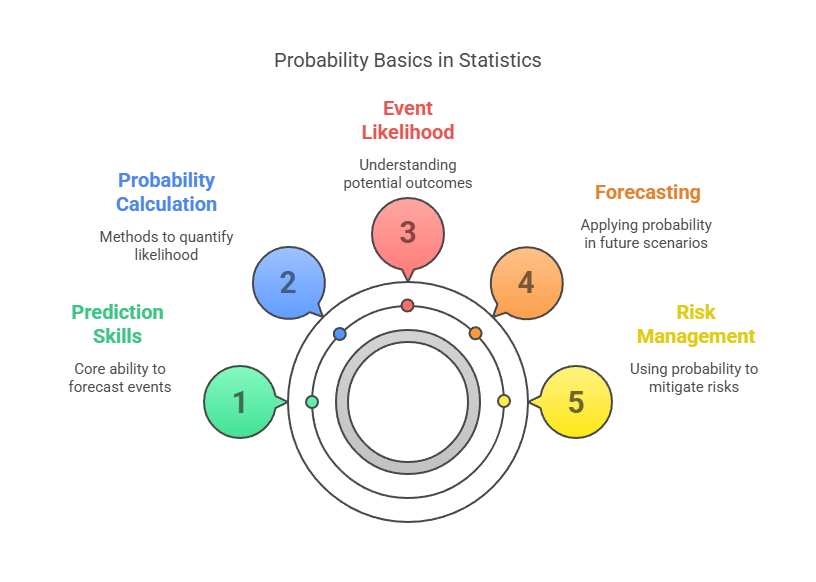
How to Use U2xAI for SPARK:
- Structured Learning (S):
➔ Ask U2xAI to explain basic probability, combinations, and independent events. - Practical Case Mastery (P):
➔ Solve mini-cases: Predict the probability of late shipments based on historical delay rates. - Actionable Practice (A):
➔ Solve 3 probability problems with immediate walkthroughs. - Real Interview Simulations (R):
➔ Mock question: "If 30% of shipments get delayed, what's the probability two shipments are both late?" - Killer Mindset Training (K):
➔ Affirmations for handling "surprise" math questions with calm step-by-step thinking.
Day 10: Statistics — Hypothesis Testing
Introduction:
Today, you’ll master the basics of testing business assumptions with data, using p-values and hypotheses — essential for A/B testing and decision making.
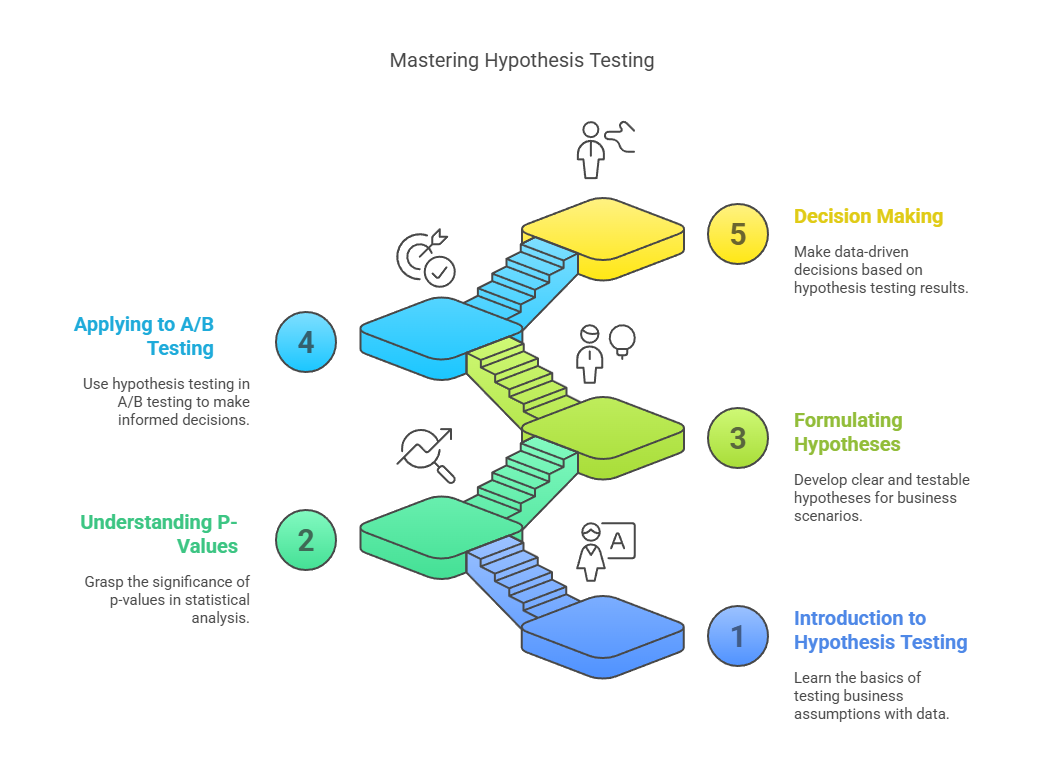
How to Use U2xAI for SPARK:
- Structured Learning (S):
➔ Get simple explanations for Null Hypothesis, Alternative Hypothesis, and P-Values. - Practical Case Mastery (P):
➔ Simulate tests like: "Is the new supplier's defect rate different from the old supplier?" - Actionable Practice (A):
➔ Solve 3 mock hypothesis test setups and interpret p-values. - Real Interview Simulations (R):
➔ Practice Q&A: "How would you design a simple A/B test to check if a new promotion is effective?" - Killer Mindset Training (K):
➔ Visualization exercise: explaining complex statistics simply under pressure.
Day 11: Data Life Cycle — Overview
Introduction:
Today you understand the entire journey of data: how it's born, cleaned, analyzed, and turned into decisions.
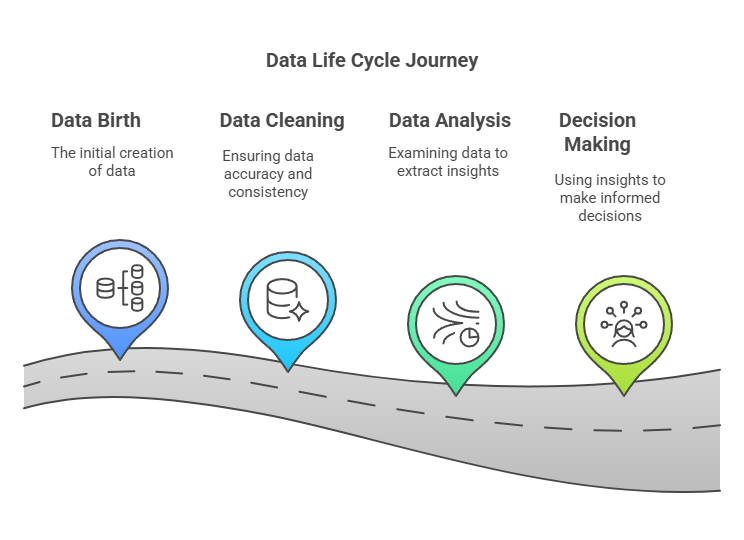
How to Use U2xAI for SPARK:
- Structured Learning (S):
➔ Request a detailed but simple breakdown of each data life cycle phase: Business Understanding ➔ Collection ➔ Cleaning ➔ Analysis ➔ Decision Making. - Practical Case Mastery (P):
➔ Simulate a project: "Analyze customer churn from first meeting to final report." - Actionable Practice (A):
➔ Build a mini checklist for steps in a real project. - Real Interview Simulations (R):
➔ Mock Interview Q&A: "Where does data quality usually fail, and how would you catch it early?" - Killer Mindset Training (K):
➔ Visualization: "Picture the full pipeline from raw messy data to a beautiful insight dashboard."
Day 12: Data Life Cycle — Data Cleaning Focus
Introduction:
Today is about getting hands-on with one of the most critical — and messy — parts of analytics: data cleaning.
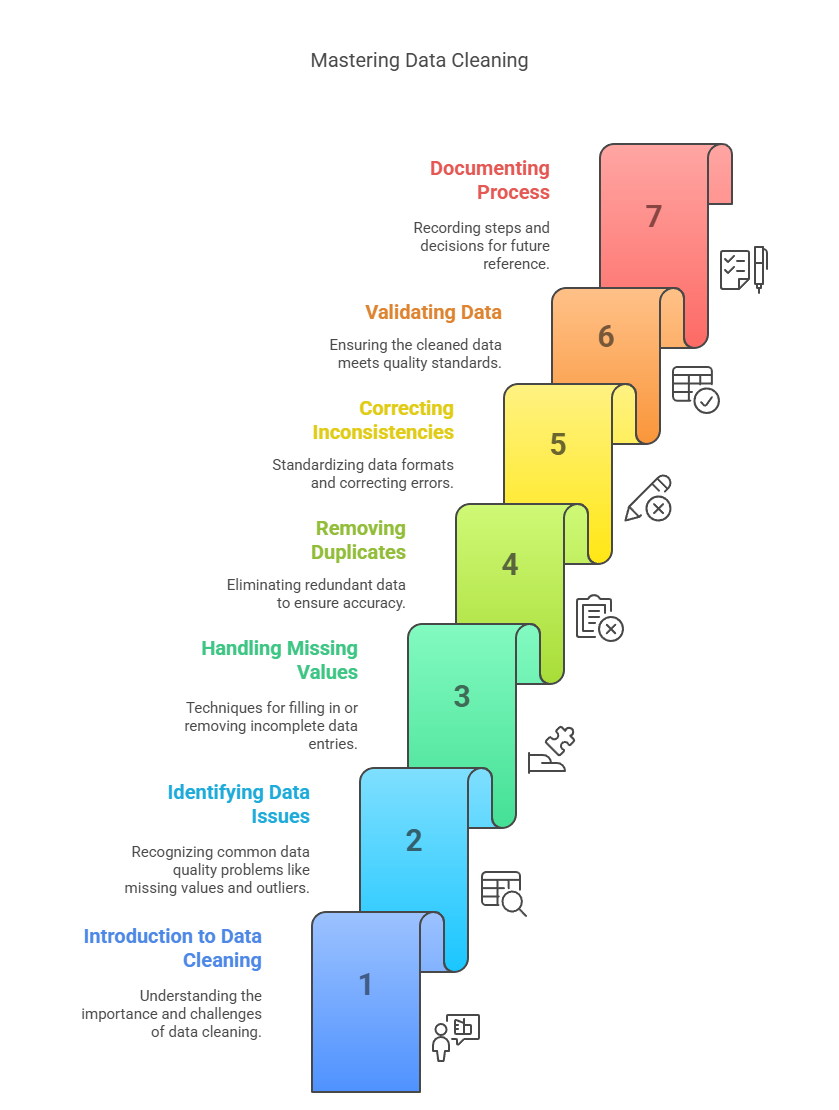
How to Use U2xAI for SPARK:
- Structured Learning (S):
➔ Ask U2xAI to explain how missing values, duplicates, and outliers are handled. - Practical Case Mastery (P):
➔ Get a messy supply chain dataset to clean (fill missing supplier names, remove duplicate purchase orders). - Actionable Practice (A):
➔ Perform 3 real cleaning tasks and validate results with U2xAI feedback. - Real Interview Simulations (R):
➔ Practice answering: "What’s your process when you receive incomplete data?" - Killer Mindset Training (K):
➔ Mental reminder: "Cleaning is a superpower, not a boring task."
Day 13: Business Problem Solving
Introduction:
Today you practice the most critical real-world skill: translating business language into data analytics projects.
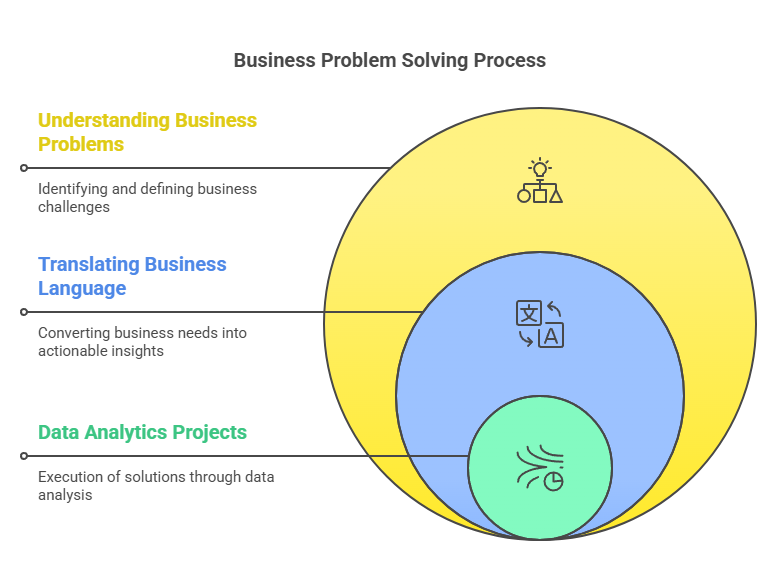
How to Use U2xAI for SPARK:
- Structured Learning (S):
➔ Ask for a process: How to break vague business problems into data questions. - Practical Case Mastery (P):
➔ Practice translating problems: "How do we increase customer retention?" into measurable KPIs and data tasks. - Actionable Practice (A):
➔ Translate 3 real-world business situations into analytics projects. - Real Interview Simulations (R):
➔ Mock case: "An e-commerce site’s revenue is falling. What’s your analytics approach?" - Killer Mindset Training (K):
➔ Visualization: Think like a consultant — structured, strategic, confident.
Day 14: Weekly Mock Interview
Introduction:
Today you pull everything together: statistics, data life cycle thinking, problem solving — under real-time conditions.
How to Use U2xAI for SPARK:
- Structured Learning (S):
➔ Review key concepts briefly with U2xAI quick quizzes. - Practical Case Mastery (P):
➔ Solve 2 full mini-cases end-to-end: framing the problem ➔ choosing the method ➔ explaining insights. - Actionable Practice (A):
➔ Practice structured answers using SPAR format. - Real Interview Simulations (R):
➔ 45-minute full mock interview through U2xAI focused on business problem-solving and data life cycle. - Killer Mindset Training (K):
➔ Final breathing + mindset visualization exercise before and after the mock.
Purpose of Week 3: Full Professional Interview Readiness
This week focuses on turning technical skills into business storytelling, mastering end-to-end analytics projects, and building final mock interview confidence.
You will learn, apply, practice, simulate, and train mindset daily with the SPARK Framework, powered by U2xAI.
"Data without storytelling is noise. Data with visualization becomes action."
What You Will Learn in Week 3:
| Focus Area | Key Learning Highlights |
|---|---|
| Data Visualization - Fundamentals | Learn when and why to use bar, line, pie, and scatter charts. Practice choosing the right chart for business problems and confidently explain your choices during interviews. |
| Data Visualization - Hands-On Practice | Create charts in Google Sheets or Excel to visualize inventory shortages and sales trends. Practice presenting insights visually with clarity and confidence. |
| Dashboard Thinking | Learn dashboard design principles, select the right KPIs, and build basic dashboard drafts for business storytelling, focusing on clarity, flow, and business relevance. |
| Spreadsheet Basics for Data Analysis | Master navigating, sorting, filtering, and formatting spreadsheets. Practice organizing messy data, spotting missing values, and applying business-ready formatting techniques. |
| Spreadsheet Functions and Formulas | Learn and apply critical formulas like SUM, AVERAGE, COUNT, IF, VLOOKUP/XLOOKUP, FILTER, and SORT. Practice cleaning, summarizing, and combining datasets effectively. |
| Full Case Simulation - Supply Chain Analytics | Solve an end-to-end real-world supply chain business analytics case — from problem framing to delivering clear insights — just like in a final interview. |
| Behavioral Interview Preparation | Sharpen your ability to answer behavioral questions using SPAR/STAR frameworks. Practice storytelling techniques that build trust, leadership, and relatability in interviews. |
By the End of Week 3, You Will Be Able To:
- Select and explain the right charts for different business scenarios.
- Build real dashboards that highlight key business insights clearly.
- Clean, organize, and analyze datasets using Excel or Google Sheets efficiently.
- Use spreadsheet formulas like a professional analyst to solve real problems.
- Solve complete analytics case studies from start to finish.
- Communicate structured, impactful behavioral answers during interviews.
- Simulate a full interview experience covering technical and business rounds.
- Strengthen your interview mindset, staying calm, clear, and confident under pressure.
Day 15: Data Visualization — Fundamentals
Introduction:
Today you learn how to pick the right chart for the right business situation — the first step to telling compelling stories with data.
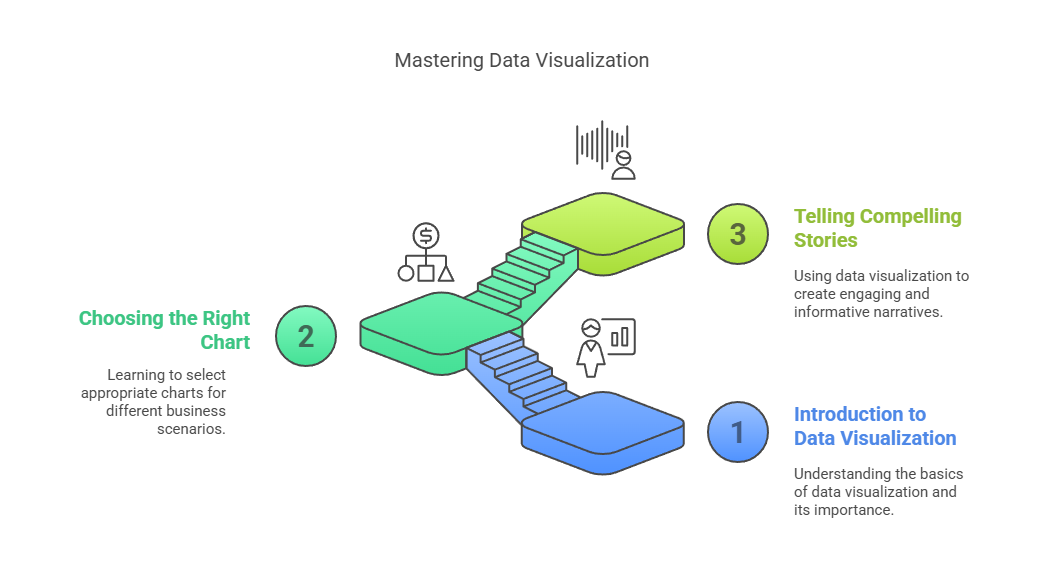
How to Use U2xAI for SPARK:
- Structured Learning (S):
➔ Learn What, Why, and How of bar, line, pie, and scatter charts. - Practical Case Mastery (P):
➔ Practice matching chart types to retail or supply chain datasets. - Actionable Practice (A):
➔ Solve 5 mini-exercises selecting correct charts. - Real Interview Simulations (R):
➔ Answer mock questions: "What chart would you use to show monthly sales trends?" - Killer Mindset Training (K):
➔ Visualize yourself confidently explaining chart choices during presentations.
Day 16: Data Visualization — Hands-on Practice
Introduction:
Today you practice actually building charts in Google Sheets or Excel to present business data professionally.
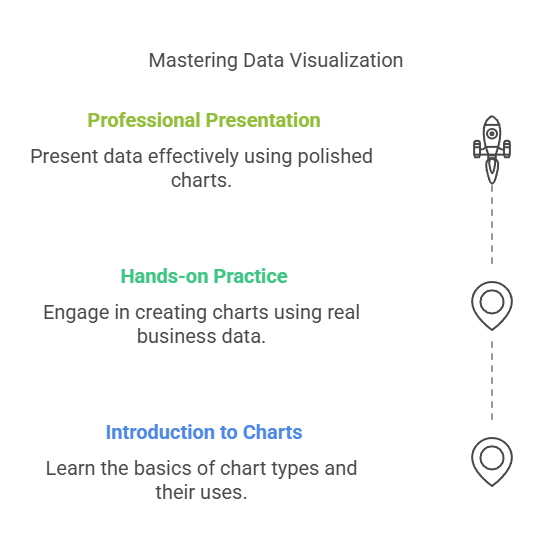
How to Use U2xAI for SPARK:
- Structured Learning (S):
➔ Learn key formatting best practices: labeling axes, choosing colors, highlighting insights. - Practical Case Mastery (P):
➔ Create 2 charts visualizing inventory shortages and monthly sales trends. - Actionable Practice (A):
➔ Complete a visualization challenge and get U2xAI review. - Real Interview Simulations (R):
➔ Mock task: "Create a sales trend chart and explain the insights in 2 minutes." - Killer Mindset Training (K):
➔ Visualization exercise: Calmly presenting charts in a business meeting.
Day 17: Dashboard Thinking
Introduction:
Today you’ll think like a business analyst: choosing KPIs, designing dashboards, and telling end-to-end stories visually.
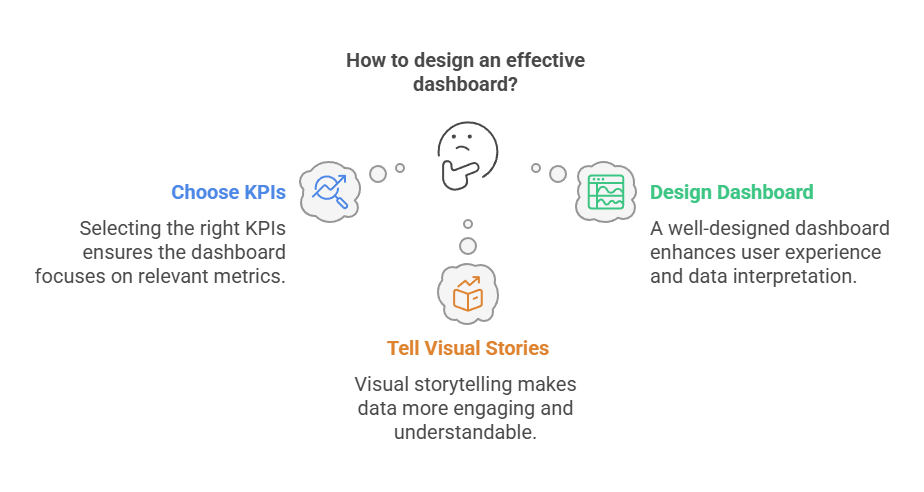
How to Use U2xAI for SPARK:
- Structured Learning (S):
➔ Learn key dashboard design principles: simplicity, relevance, flow. - Practical Case Mastery (P):
➔ Draft a supply chain KPI dashboard: On-time delivery %, Inventory Turnover, etc. - Actionable Practice (A):
➔ Sketch a mock dashboard and get U2xAI feedback. - Real Interview Simulations (R):
➔ Mock task: "Design a dashboard for warehouse efficiency tracking." - Killer Mindset Training (K):
➔ Affirmations: "I think like a business storyteller, not just a coder."
Day 18: Spreadsheet Basics for Data Analysis
Introduction:
Today you’ll master how to navigate, organize, and analyze data effectively using Excel or Google Sheets — setting the foundation for fast, error-free analysis.
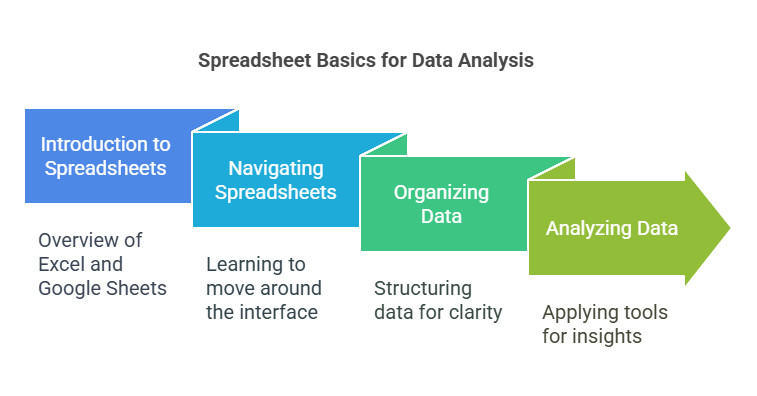
How to Use U2xAI for SPARK:
- Structured Learning (S):
➔ Request U2xAI to explain the basic spreadsheet concepts:- Cell references (relative, absolute, mixed)
- Sorting and filtering data
- Freezing panes, conditional formatting.
➔ Ask U2xAI for "Explain What, Why, and How of cell referencing."
- Practical Case Mastery (P):
➔ Solve a mini case:
"Given a product sales dataset, sort by sales value, filter products sold in January only, and highlight top 5 sales using conditional formatting." - Actionable Practice (A):
➔ Complete 5 small tasks with U2xAI guidance:- Freeze header rows,
- Sort orders by region,
- Apply conditional formatting rules,
- Highlight missing values,
- Add basic filters.
- Real Interview Simulations (R):
➔ Simulate a quick task: "Sort a customer database by last purchase date and highlight customers inactive for 90 days." - Killer Mindset Training (K):
➔ Visualization exercise: Picture calmly navigating a messy spreadsheet during a live test, quickly organizing it neatly.
Day 19: Spreadsheet Functions and Formulas for Analysis
Introduction:
Today you’ll dive deeper — learning how to analyze, summarize, and clean data using essential formulas that analysts use every day.
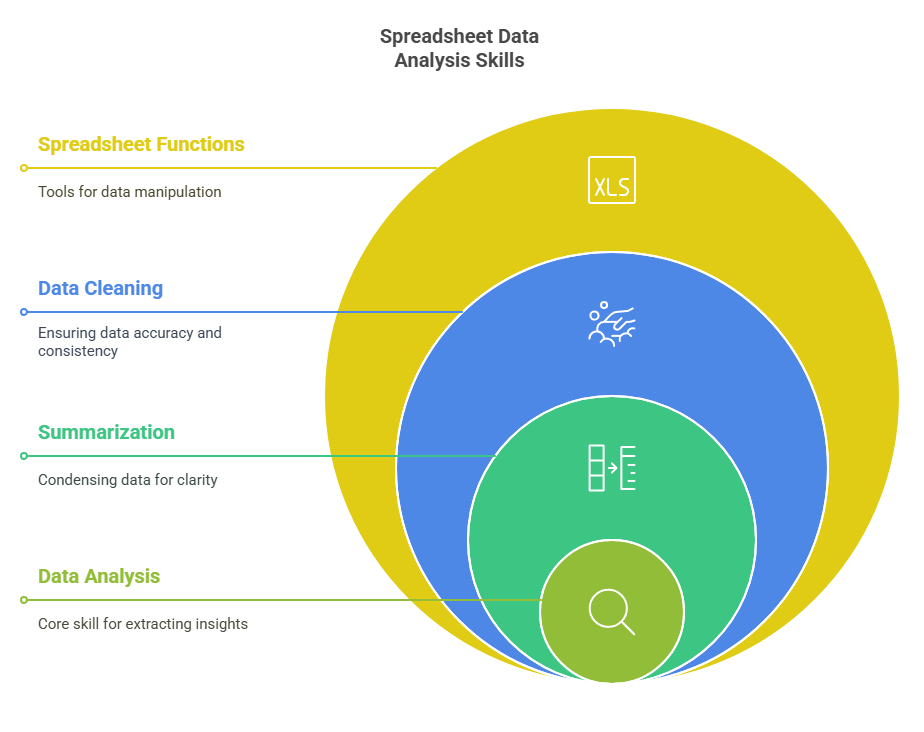
How to Use U2xAI for SPARK:
- Structured Learning (S):
➔ Request U2xAI to explain core data analysis formulas:SUM(),AVERAGE(),COUNT(),IF(),VLOOKUP()/XLOOKUP(),FILTER(),SORT().
➔ Ask U2xAI for examples: "Explain why VLOOKUP matters in combining datasets."
- Practical Case Mastery (P):
➔ Solve a mini case:
"Use VLOOKUP to match product IDs from a sales table to a product catalog table and return product names."
"Use IF() formulas to flag sales below $100 as 'Low Sale'." - Actionable Practice (A):
➔ Solve 5 hands-on exercises:- Calculate total monthly sales,
- Find average customer order size,
- Flag duplicate orders,
- Lookup missing product details,
- Create a simple dynamic report using
FILTER().
- Real Interview Simulations (R):
➔ Practice a scenario:
"You’re given two messy datasets. Combine them using VLOOKUP and identify missing entries." - Killer Mindset Training (K):
➔ Affirmations: "I approach formulas step-by-step. I verify and double-check with calm focus."
Day 20: Full Case Simulation — Supply Chain Analytics
Introduction:
Today you solve a complete end-to-end business case — from understanding the problem to delivering final insights, just like in real interviews.
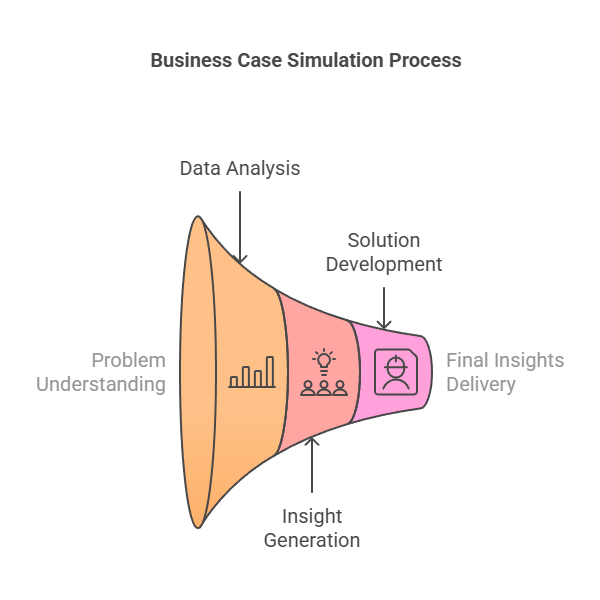
How to Use U2xAI for SPARK:
- Structured Learning (S):
➔ Frame the case clearly: business context + data need + analysis plan. - Practical Case Mastery (P):
➔ Solve a real-world supply chain analytics case with U2xAI prompts. - Actionable Practice (A):
➔ Create and submit your final case solution for U2xAI feedback. - Real Interview Simulations (R):
➔ Practice answering: "What insights did you find? What actions would you recommend?" - Killer Mindset Training (K):
➔ Affirmations for full-case confidence: "I can structure and solve complex problems calmly."
Day 21: Behavioral Interview Preparation
Introduction:
Today you sharpen your storytelling and communication skills — learning to answer behavioral questions with clarity and authenticity.
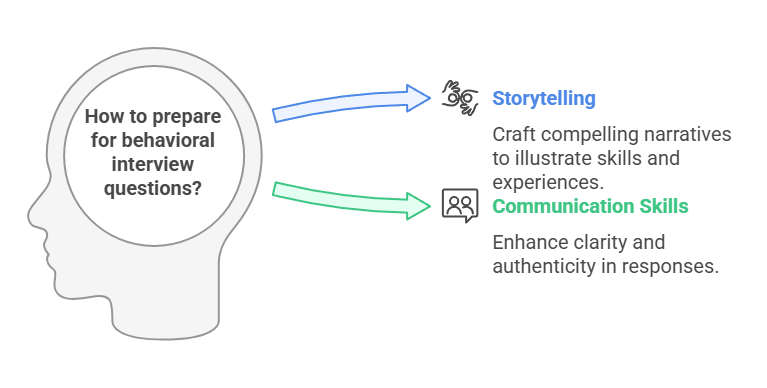
How to Use U2xAI for SPARK:
- Structured Learning (S):
➔ Review SPAR/STAR methods for framing answers. - Practical Case Mastery (P):
➔ Practice common scenarios like leadership challenges, conflict resolution, big achievements. - Actionable Practice (A):
➔ Role-play 5 behavioral questions and get detailed feedback from U2xAI. - Real Interview Simulations (R):
➔ Mock Q&A session: behavioral focus. - Killer Mindset Training (K):
➔ Visualization: Building rapport, smiling, telling stories authentically.











